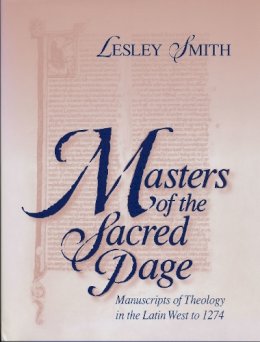Lesley Smith is Academic Bursar and Tutor in Politics at Harris Manchester College in the University of Oxford.
“Lesley Smith's book provides a succinct and lucid summary of the state of research on the history and context of 'sacra pagina' in the schools, which her own research has so significantly furthered. This alone will win her the profuse thanks of non-specialists, to whom this subject has too long remained murky or inaccessible. Specialists can rejoice, not only in the masterful introduction, but in the wonderfully illuminating and richly commented plates depicting the manuscripts themselves: as much characters in the history of theology as the masters themselves. I plan to assign this book in my course on the medieval schools next Fall.”—Theresa Gross-Diaz, Associate Prof. History, Loyola University, Chicago “In a single volume the author, Lesley Smith, brings together through illustrations and commentary a far-ranging selection of sacred texts and the medieval manuscripts that contained them. She unveils the sacra pagina in its various manifestations—from the brilliantly illuminated Historia Scholastica of Peter Comestor to the manuals and reference tools necessary for the everyday life of sermons and sin.” —Barbara A. Shailor, Beinecke Rare Book and Manuscript Library, Yale University This book is a wonderful contribution to the study of medieval culture. The schools of the twelfth and thirteenth centuries, beginning as foundations of study for the clergy associated with cathedrals, grew into secular universities. Smith is right to point out that this was essentially an epistemological change, and that it had far-reaching consequences, even in a field as seemingly conservative as theology. Masters of the Sacred Page combines a concise and insightful summary of the history of medieval education with a judicious selection of 30 plates of twelfth and thirteenth-century manuscript pages illustrating these changes. This combination will be an excellent classroom tool, but it will also be of great usefulness to professional medievalists, many of whom have never seen what a medieval verbal concordance of the Scriptures looked like, or how the page layout changed from sentence collections to summae. Only a scholar with a remarkable command of manuscript materials could have brought us such a rich and unusual collection.”—E. Ann Matter, Professor of Religious Studies, University of Pennsylvania “...[W]hile the beautiful crafting of the book and the natural allure of its manuscript reproductions will draw the eye, the highly useful Introduction will catch the mind, especially of teachers. This work is an essential acquisition for serious theological libraries, and a highly recommended resource for teachers of medieval theology, especially for in-class use."—Theological Studies “For the student of medieval intellectual and literary culture, nothing can replace the experience of handling the physical artifact by which ideas and insights were communicated to a medieval student. The quality of reproduction of the thirty black-and-white plates in this volume is excellent. The volume is... rich in its illustration and description of a wide range of medieval theological manuscripts, in particular of the twelfth and thirteenth centuries.”—Speculum “Dr. Smith has provided in this short study a lively visual and intellectual introduction to a series of key texts, each with remarks on the content and a facing page from a manuscript, with an explanation to the reader of what he is seeing and what to look for in similar examples. In a clear and accessible introduction she sets them in their contemporary context of study. There is nothing quite like this in the literature; it will prove an indispensable tool and not only for students.” —Journal of Theological Studies “Lesley Smith’s work is well organized and a marvel of compact information. Smith offers students a concise yet richly detailed account of medieval theology and pedagogy, including the rise of universities. The high quality photographs of manuscripts give students the chance to practice the reading of manuscripts.” —Medievalia and Humanistica “This intelligently-designed book puts the reader into close contact with the pages of thirty key manuscripts of medieval theology, broadly interpreted. These manuscripts, ranging in date from the ninth through the thirteenth century, have been selected deftly to illustrate major themes of high medieval theology, from the biblical to the systematic to the practical. Each is presented succinctly in terms of both content and physical format. It is the expert attention paid to physical form, and especially to page layout, that give the book its unique character: for example, the demonstration, in just two pages, of salient features in a leaf from Herbert of Bosham’s expansion of Peter Lombard on the Psalms is a real feat of concise teaching. Courses in medieval theology, intellectual history, and ecclesiastical history can be much enhanced by the riches offered here.” —Richard W.Pfaff, Professor of History, University of North Carolina, Chapel Hill

